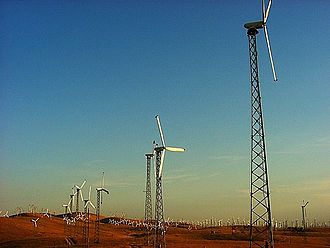Altamont Pass
| Altamont Pass | |||
|---|---|---|---|
|
Altamont Pass Wind Farm wind turbines at the top of the pass |
|||
| Compass direction | east | west | |
| Pass height | 308 m | ||
| county | Alameda County , California ( USA ) | ||
| Watershed | San Joaquin River | ||
| Valley locations | Tracy | Livermore | |
| expansion |
|
||
| Mountains | Diablo Range | ||
| map | |||
|
|
|||
| Coordinates | 37 ° 43 '57 " N , 121 ° 39' 9" W | ||
The Altamont Pass is a mountain pass in the Diablo Range east of the San Francisco Bay Area in California , which connects Livermore in the Livermore Valley with Tracy in the San Joaquin Valley . At the top of the pass is the Altamont Pass Wind Farm , one of the first and largest wind farms in the United States .
The I-580 trunk road , the Altamont Pass Road and a railway line of the Union Pacific Railroad , which is also used by the regional trains of the Altamont Corridor Express , lead over the Altamont Pass . Until the 1980s, the Southern Pacific Railroad also operated a railway line over the Altamont Pass.
On the east side of the pass lies the Altamont Speedway racecourse, made famous by the Altamont Free Concert and named after the pass .
history
At the time of the California gold rush , the pass was still called Livermore's Pass, after Robert Livermore's ranch. When the railway was built over the pass in 1869, a settlement was set up on the top of the pass which was initially called The Summit and later, in a Spanish-historical way, Alta Monte (High Mountain). The pass and the municipality from 1872 later took the name Altamonte , but the top of the pass is largely uninhabited today (the local post office closed in 1955).
Wind farm
After the two oil crises (1973/74 and 1979/80) and after the core meltdown on March 28, 1979 at the Three Mile Island nuclear power plant, the search for alternative energies began in the USA . Several thousand small wind turbines of the first generation mounted on steel towers have been installed on the Altamont Pass . In addition to systems from US companies, which, however, often turned out to be unreliable due to insufficiently developed technology due to limited experience in wind turbine construction, Danish systems in particular were installed, as the use of wind energy was somewhat more widespread in Denmark than in the USA. At the end of 1985 around 40% of Californian wind turbines came from Denmark, which, in addition to domestic sales in Denmark itself, contributed significantly to the development of the Danish wind energy industry, which is still important today.
The wind farm had (as of January 2011) a capacity of 558 MW (4,930 turbines), corresponding to a nominal output of approx. 110 kW per turbine. Modern systems (as of 2012) have a nominal output of around 2 to 3 MW. Since the existing systems are very outdated (a not inconsiderable number even defective), the number of wind turbines is to be significantly reduced in the course of repowering .
swell
- ↑ Erich Hau, Wind Power Plants: Fundamentals, Technology, Use, Economic Efficiency, Berlin - Heidelberg 2008, pp. 58–63.
- ↑ CalWEA.org = Californian Wind Energy Association ( Memento from February 3, 2012 in the Internet Archive )

